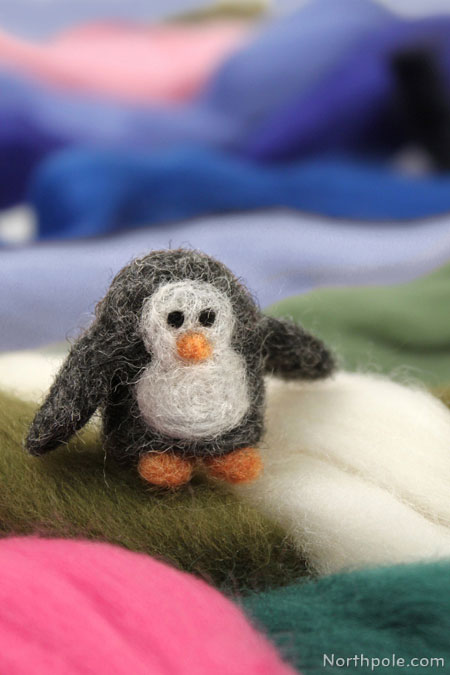Skill Level:
Crafting Time:
Technique(s):
Material(s):
Category:
Share This Craft
Search Crafts
Needle Felting 101

What is Needle Felting?
Needle felting is the act of interlocking wool fibers by repeatedly poking the fibers with a felting needle. On a microscopic level, the wool fibers are barbed and scaly, so when you use a felting needle (which has barbs on the shaft), the wool’s scales rub together, and the fibers interlock. The needle’s barbs are only “one-way,” so it creates friction as you insert it into the wool, but not as you pull the needle out of your project. By repeatedly poking the wool with this special needle, the fibers become more intertwined, creating a permanent bond. Essentially, wool sticks to itself, which is why you don’t need glue or other adhesives when needle felting.
What Kinds of Things Can I Make?
With needle felting, you can make all sorts of projects, such as accessories, jewelry, ornaments, or figurines. For a quick project idea, you can add wool roving or yarn to a wool base, such as a wool felt clutch, scarf, or mittens. If you want to make some simple ornaments, you can use cookie cutters to turn roving into perfectly formed felt shapes. To make cute little figurines, check out this tutorial. Once you become acquainted with needle felting and you want to step up your craft, then you might be ready to enter into the realm of needle felting on an armature.
What Supplies Do I Deed to Get Started?

Felting needle – You can purchase either a single needle or a tool with multiple needles. A needle tool with multiple needles allows you to felt faster, and it has a plastic guard to help protect your fingers. A single needle allows you to have more precision when you add details onto projects. The needles sometimes break, so it is a good idea to keep extras on hand.
Foam block – A foam block (or a needle felting mat) is your work surface when creating needle felted objects. You can buy a foam block at the craft store or you can salvage a piece. Just about any foam will work, but be careful of white Styrofoam—the little foam balls can easily get stuck on the back of your project
Needle felting mat – A needle felting mat (or a foam block) is your work surface when creating needle felted objects. There are a couple different kinds of needle mats: one is a brush mat and the other is a foam mat. Either of these is suitable for needle felting, and both can be found at most craft stores or online. The advantage to using a mat instead of a foam block is that it has a base. So if you really want to craft while sitting on the sofa, you could work with the mat on your lap since the base will protect you from the needle jabs.
Thimble – A thimble is handy little tool to have when needle felting. It will help protect your fingers from the needle, as it can be easy to accidentally poke yourself.
Wool roving – Roving is unspun wool fibers that can be fashioned into whatever your heart desires. Make cute little figurines or any other shapes you want.
Wool yarn – Yarn that is 100% wool is ideal for felting. If you do use a wool/acrylic blend, look for one with at least 80% wool content. Don’t use wool that is labeled “superwash” because it will not felt. This wool has been chemically treated with resin that coats the fibers and cannot be removed through washing or wearing. The resin coating makes the fibers slick, covering the scaly surface, and thus preventing the fibers from felting.
Elfy Hints:
- If using a foam block without a protective base, keep in mind that the needle can poke through the foam. Therefore, you wouldn’t want to needle felt in your lap, and if you are working on your dining table, you should place cardboard or a cutting mat beneath the foam so you don’t scratch the table.
- To use your needle, poke your project with a straight up and down motion. The reason for this specific motion is so that you don’t break the needle. If you pull the needle out at a different angle than how you inserted it, you will be putting pressure on the needle, and it will likely break.
- If you need to poke the side of your project, rotate the project so that side is facing up and then proceed to poke up and down. If you don’t do this and try to poke your project sideways, you will probably poke yourself. When the side you are working on is facing up, the needle will go into the foam, not your fingers (ouch!).
- Occasionally lift your project from the foam (or mat) to prevent the fibers from getting stuck in the foam. Each time you lift your project from the foam, you are pulling fibers out of the foam and allowing them to lie closer to the surface of your project; this helps you in felting the fibers.
What Else Do I Need to Know?
There are no mistakes in needle felting. If your project doesn’t look how you intended, don’t give up! Just keep at it until you are pleased with how it looks. If one area is too fluffy or bulging, keep poking it until you accomplish the desired shape. If you poked it too much and now have a divot or recessed spot, simply add more roving. Above all else, have fun!
Hungry for more? If you’re really into felting and want to experiment with other techniques, you may be interested in wet felting. Check out this article on how to felt wool sweaters.
Ready to Start Crafting? Check Out Some Projects That Use This Technique:















